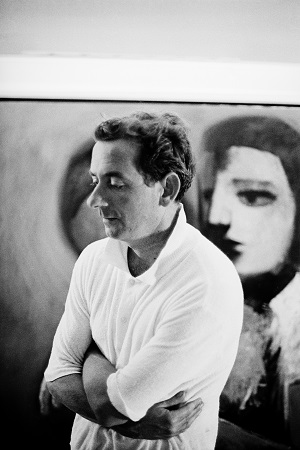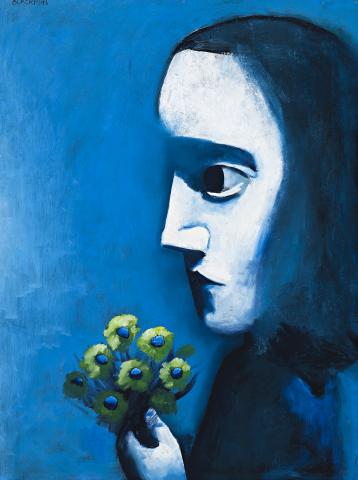GIRL WITH FLOWERS, c.1958
CHARLES BLACKMAN
oil on composition board
122.0 x 91.0 cm
signed upper left: BLACKMAN
bears Australian Galleries cat. verso: AG413
Australian Galleries, Melbourne
Sam and Tess Rose, acquired from the above in May 1963
Gould collection, Melbourne, acquired from Tess Lang (formerly Rose) in 1995
possibly: Second Anniversary Exhibition, Australian Galleries, Melbourne, June 1958
23.Charles Blackman Woollahra 1966 Photograph by Robert McFarlane Courtesy Josef Lebovic Gallery (2).jpg

A delightful charmer, Blackman always pulled himself together for major occasions and spoke at three openings at my Melbourne and Sydney galleries, most notably launching our landmark exhibition The Antipodeans in 2003.
Gould Galleries held three solo Blackman exhibitions. The gallery was instrumental in the location and loans for Charles Blackman: Alice in Wonderland, National Gallery of Victoria, Melbourne, in 2006 and Charles Blackman: Schoolgirls, currently viewing at Heide Museum of Modern Art. ROB GOULD
Although Charles Blackman received strong critical notice for his now-famed Alice in Wonderland paintings, it was his subsequent series of young girls and flowers that truly found him popular acclaim. First exhibited in early 1958 at the Terry Clune Galleries in Sydney (where purchasers included the Art Gallery of New South Wales, Sydney), Blackman then showed a small group at the Australian Galleries, Melbourne in June before an augmented selection travelled to Brisbane as one of the first exhibitions mounted in Brian Johnstone’s new gallery building in Bowen Hills. The financial success of this show was a major boon for the artist and particularly for his Queensland-born wife Barbara, for she was the inspirational muse for the whole series.
In Girl with Flowers, c.1958 the young woman’s eyes are shrouded in deep shadow and stare beyond the picture frame in a thoughtful yet ‘unseeing’ attitude. Barbara, a writer and poet, was already legally blind when she married Blackman in 1952, a condition which worsened considerably over the next decade to the point that these paintings were amongst the last she was able to truly perceive using her eyes alone. By 1958, the artist was working at Georges and Mirka Mora’s Bistro Balzac and had also come within the orbit of the art patrons John and Sunday Reed, who were instrumental in getting one of Blackman’s ‘Alice’ paintings accepted for the Collection of the Musée d’Art Moderne in Paris that same year, a spectacular achievement for any Australian artist. Similar connections also led to his invitation to join the group of artists who exhibited under the banner of The Antipodeans the following year. After the Sydney exhibition with Terry Clune, the Blackmans returned to Queensland staying with friends near the luxuriant flower farms surrounding Mount Tambourine. Given Barbara's condition, Blackman focussed his painterly attention to the senses that now gained greater importance in her perception of the world around her, those of touch and smell. Such intimate scrutiny is particularly evident in Girl with Flowers, a ‘world of trance and dream – of things sensed rather than seen.’1
As Blackman would later comment on the series, ‘what emerged was that in relation to (flowers) human beings start to do certain kinds of things … that is, the flowers evoked the people, in a certain kind of gentility, or substance, or reverence, or sensitivity.’2 In Girl with Flowers, Barbara sits within an atmospheric blue background devoid of any subject beyond its brushwork, and all attention inevitably focuses on her eye, distinctive nose and the vivid yellow-green flowers she clutches in her hand. The critic Gertrude Langer also noted this effect: ‘Bathed in a light that has its source in the luminous colours, these inward gazing faces full of a gentle sadness, these flowers, which often seem like souls of flowers, have a stringent poetry that lingers in the mind.’3
1. ‘The Antipodeans’, Modern Art News (Contemporary Art Society broadsheet), Melbourne, vol.1, no.1, August 1959, p. 9
2. Shapcott, T., Focus on Charles Blackman, University of Queensland Press, Brisbane, 1967, p. 36
3. Langer, G. Courier Mail, Brisbane, 18 November 1958
ANDREW GAYNOR
